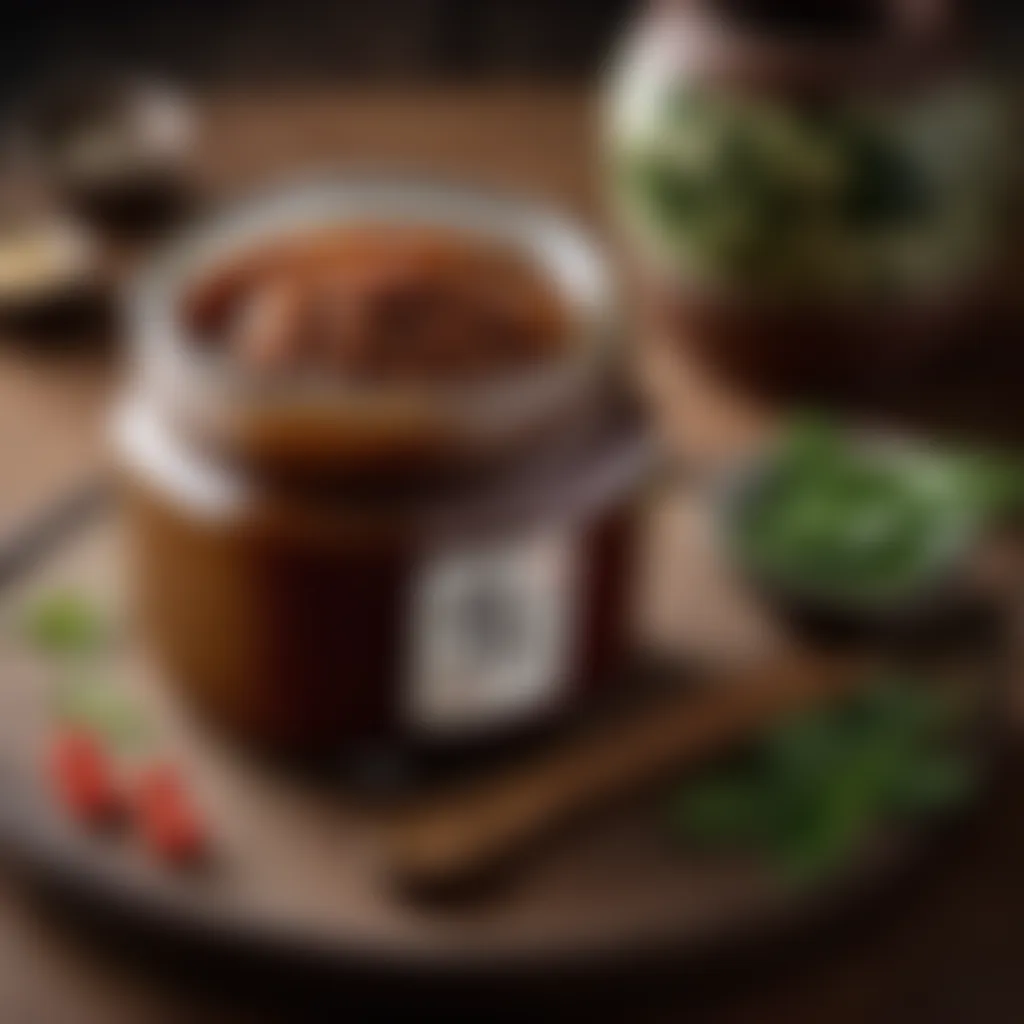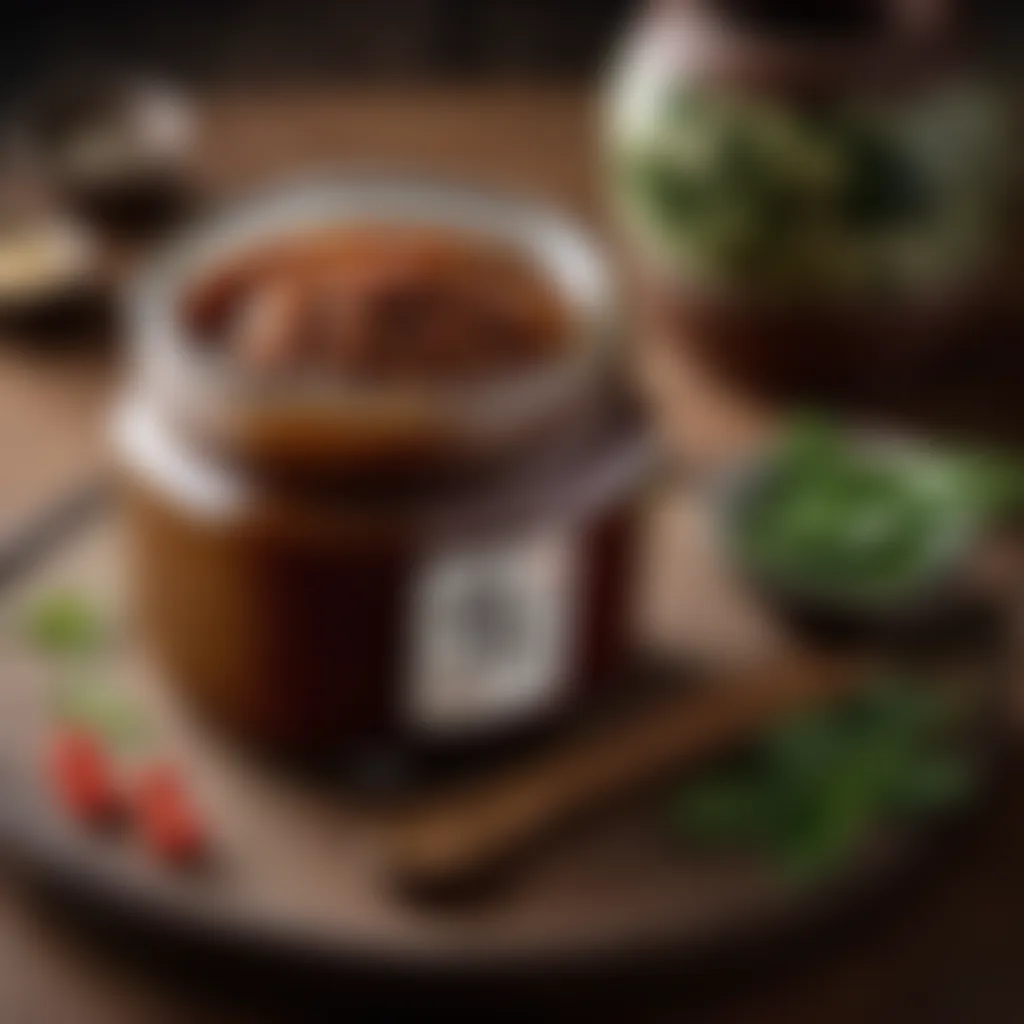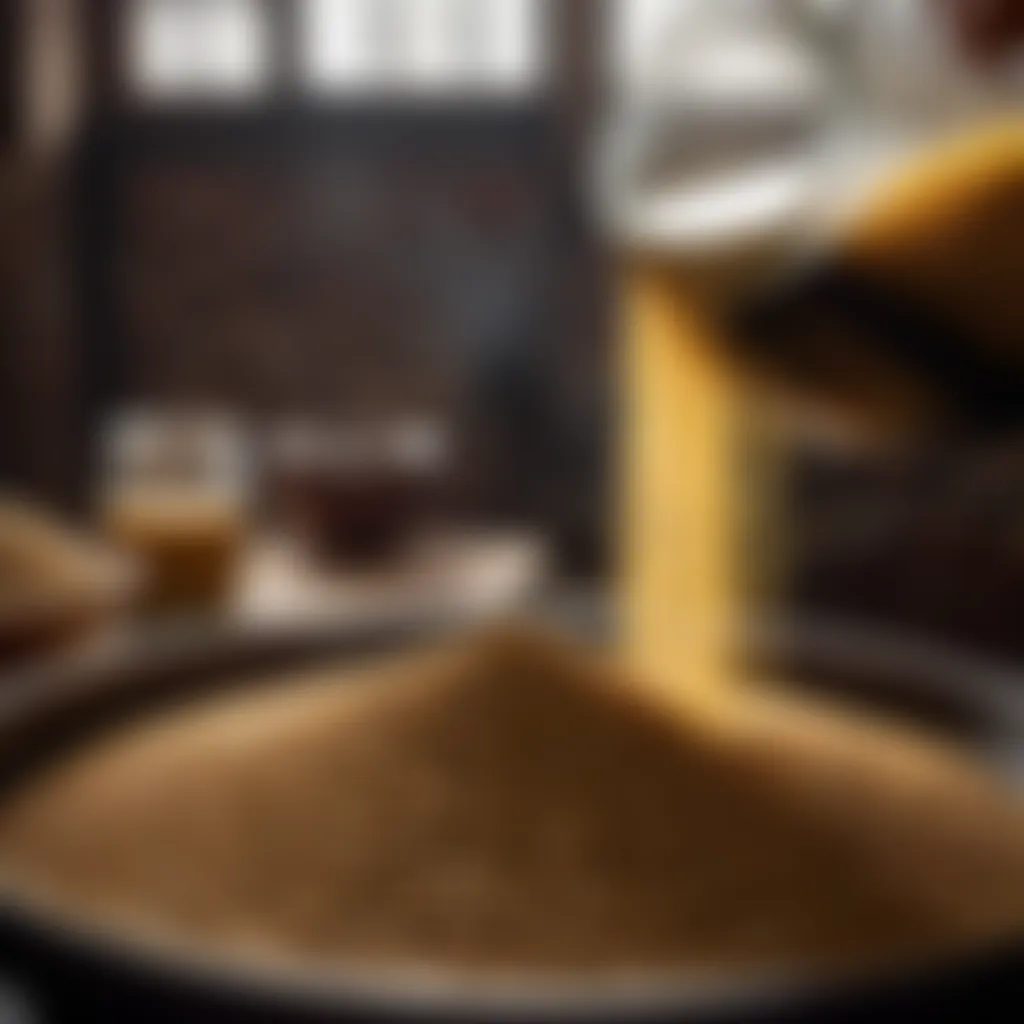Crafting Doenjang: A Traditional Korean Fermented Paste


Intro
Doenjang, a fermented soybean paste, is more than just a condiment in Korean cuisine; it’s a storied essence of tradition and culture. Making this staple is a time-honored process that brings together history, nutrition, and culinary artistry. The deep umami flavor of doenjang enhances countless dishes, making it a beloved ingredient in Korean households. This guide will walk you through the practical steps of making your own doenjang, ensuring a rich understanding of what goes into crafting this exquisite paste.
Ingredients:
To embark on the journey of making your own doenjang, you must gather the essential ingredients. Here's a rounded list with precise measurements:
- Soybeans: 2 cups
- *Salt and Water: both should amount to about 2-3 cups to create the brine for fermentation
- Barley powder (or wheat flour): 1 cup, optional but enhances fermentation
- Cooking stones or weight for pressing (optional)
Preparation Steps:
Step 1: Soaking the Soybeans
Begin by rinsing the soybeans thoroughly. Place them in a large bowl, and cover with water. Make sure to soak them for at least 12 hours or overnight. This soaking process is crucial as it allows the beans to swell and soften, preparing them for cooking.
Step 2: Cooking the Soybeans
Once soaked, drain the beans and transfer them to a pot. Cover them with fresh water and bring to a boil. Reduce to a simmer and cover, cooking for about 3-4 hours until the beans are tender. Stir occasionally to prevent sticking.
Step 3: Pureeing the Cooked Soybeans
Let the cooked beans cool slightly. Then, transfer them to a blender or food processor. Add a touch of water if necessary, and blend until you achieve a thick paste. The consistency should resemble a thick hummus.
Step 4: Mixing
In a large bowl, combine the soybean paste with the barley powder or wheat flour, if using. Mix in salt to taste (aim for around 1-2 tablespoons). Ensure the mixture is well combined.
Technical Aspects:
Temperature Settings
While making doenjang, temperature control is not as critical as during other cooking processes. However, during fermentation, aim to keep the mixture in a cool place that stays around room temperature, ideally 20-25°C (68-77°F).
Timing Specifics
Fermentation can take anywhere from 3 months up to a year, depending on the desired depth of flavor. Keep an eye on it regularly, tasting every few weeks to check for progress.
Critical Techniques
A key technique is ensuring the paste does not dry out during fermentation. It might help to cover your container with a clean cloth instead of a tight lid, allowing airflow while keeping unwanted pests at bay.
Cooking Process:
After the initial mixing, place your soybean mixture in an airtight container. Make sure to press it down firmly; this can also be facilitated with cooking stones or weights. Store this container in a decent spot with consistent temperature and check on it periodically.
Sequential Steps:
- Transfer the mixed paste into the fermentation container and press it firmly.
- Cover and place the container in a cool, dark area of your house.
- Check on the fermentation every few weeks, re-stirring if needed and tasting for readiness.
Troubleshooting Tips:
- If you notice a very sharp scent, this could mean it’s fermenting too fast. Try to lower the temperature if possible.
- If your paste seems too watery, ensure you’re using the right ratio of salt. Adjust during your next batch by adding more salt gradually.
Making doenjang is an experience, almost like crafting an artwork. Each batch will yield slightly different flavors, artfully tied to the time, place, and ingredients used.
As you embark on this culinary adventure, remember that patience pays off. The end result will not only be a delicious addition to your meals but a link to a rich cultural heritage.
Prolusion to Doenjang
Doenjang, the heart and soul of traditional Korean cooking, isn’t just a mere ingredient; it’s a cultural artifact deeply rooted in the history of Korea. The significance of introducing this staple condiment can't be overstated, as it opens the door to not only culinary delights but also a kaleidoscope of cultural practices and values that have been passed down through generation to generation. Understanding doenjang is like peeling back layers of a complex onion, revealing flavors and stories that enhance every dish it graces.
Within the realm of Korean cuisine, doenjang serves as a versatile base for numerous recipes, acting as a flavor enhancer, a seasoning, or even a fundamental component in a variety of traditional side dishes called banchan. The simple act of mixing doenjang into soup or using it as a dip can transform the mundane into the extraordinary.
This article will take a closer look at what makes doenjang unique, starting from its historical context through to its essential ingredients and fermentation processes. This journey not only emphasizes its culinary prowess but also highlights its significance in the Korean way of life, from family dinners to festive celebrations.
The Historical Context
To appreciate the value of doenjang in modern cuisine, one must first traverse back in time, observing how this humble paste emerged. The origins of doenjang can be traced back to ancient Korea, where fermented foods were pivotal for preservation in an agricultural society. The Klingsmen of the Joseon Dynasty certainly had their fair share of challenges when it came to infusing flavors into their meals, thus leading to the adaptation of fermentation techniques.
Initially, soybeans were introduced to Korean agriculture due to their adaptability to the local climate and soil. As these beans were harvested, their fermentation began a relationship that would last centuries. Evidence suggests that people were eating fermented soy products in Korea as early as the 1st century AD. Traditional recipes and methods of fermenting soybeans evolved, aligning closely with the seasons and regional agricultural practices.
What makes the historical context enriching is not merely the techniques but also the communal aspect of sharing in this labor. Families and neighbors would often come together to make large batches of doenjang, strengthening community ties while laying the groundwork for lasting relationships through the shared labor of love.
Cultural Significance of Doenjang
Doenjang isn’t just food—it's a reflection of Korean culture and identity. Within households, this ingredient represents comfort and nurturing, often serving as the base for cherished recipes passed through generations. Its use activates warm memories of family gatherings around the dining table, where the flavor of doenjang-infused dishes creates an atmosphere of shared joy.
Moreover, the symbolic weight of doenjang transcends the kitchen. It plays a vital role in festivals and rituals, showcasing the intricate relationship between food and spirituality in Korean life. For instance, during ceremonies such as Chuseok, which celebrates the harvest, families prepare dishes that prominently feature doenjang, infusing the occasion with a sense of gratitude and togetherness.
It's noteworthy to realize that in every dollop or spoonful of doenjang, there's an entire world of tradition and significance. The vibrant nature of this paste significantly contributes to the health and vitality of Korean society, ensuring that both old and young carry forward this culinary legacy.


"Doenjang is more than just a condiment; it's the essence of what it means to eat together and celebrate the bounty of each season."
In summary, this section serves as a homage to the rich history and cultural relevance of doenjang. It prepares us for an exploration into the essential ingredients that form the backbone of this beloved paste and sets the stage for understanding how such a simple food can wield immense power in both the culinary world and the hearts of those who cherish it.
Essential Ingredients
Understanding the essential ingredients for making doenjang is fundamental to mastering this traditional Korean staple. Each component plays a significant role in developing the flavor, texture, and nutritional profile of the final product. The heart of doenjang lies in its simplicity, yet the interplay of these ingredients is what transforms a basic paste into a rich and complex condiment that has stood the test of time.
Soybeans: The Foundation
Soybeans are the bedrock upon which doenjang is built. Their high protein content and unique phytochemicals are essential for creating a paste that is not only flavorful but also nutritious. When selecting your soybeans, opt for organic varieties if possible. They carry that extra bit of flavor and health benefits.
When preparing the soybeans, you'll first soak them to help in softening. This soaking helps to unlock the beans' natural enzymes, essential for fermentation. After soaking, they are boiled until tender—this process extracts natural flavors and prepares them for the mashing phase.
Many might not realize, but the type of soybeans can influence the final taste of your doenjang. A darker soybean will yield a different flavor profile compared to lighter ones. If you're feeling adventurous, try experimenting with different types to discover new nuances and textures.
Salt: The Preserving Agent
Salt is more than just a seasoning; it’s a powerhouse preservative in the world of fermentation. Historically, it has been used to prolong the life of perishable foods. In the case of doenjang, salt ensures that unwanted bacteria and microorganisms don’t spoil the batch.
When using salt, it's crucial to opt for non-iodized varieties, such as sea salt or kosher salt. These options retain minerals and neutral flavors, allowing the natural taste of the soybeans to shine through. The right amount of salt will create that perfect balance—too much, and you risk overpowering the flavor; too little, and you don’t provide enough protection against spoilage.
A simple rule of thumb is to use about 10% of the weight of your cooked soybeans in salt. For instance, if you start with one kilogram of soybeans, consider adding 100 grams of salt.
Water: The Catalyst
Water may seem like a mundane ingredient, but its role as a catalyst cannot be overstated. It activates the fermentation process by hydrating the soybeans and salt, allowing the mixture to undergo transformation. Quality of water matters here as well; filtered water is often preferable to tap water, which may contain chemicals that could inhibit fermentation.
Moreover, the temperature of the water can significantly impact the fermentation process. Warmer water promotes faster fermentation, while colder water can slow it down, giving you more control over the developing flavor. A gentle simmering can be an effective method to prepare your boiled soybeans, creating an optimal environment for fermentation to begin.
"Each ingredient carries its unique voice, contributing to the symphony that is doenjang. Understanding their roles allows for an experience beyond mere consumption; it’s a dance of flavors, health, and history."
In summary, the essential ingredients—soybeans, salt, and water—each carry layers of significance and influence. A wise home cook will respect these elements and use them thoughtfully to create an authentic and delectable doenjang that celebrates traditional Korean culinary practices.
The Fermentation Process
The fermentation process is perhaps the heart and soul of making doenjang. It's not just about letting the ingredients sit; it's about transformation. During fermentation, the enzymes and microorganisms work their magic, breaking down the raw components into something that’s not only flavorful but also rich in health benefits. Since the soybeans are the backbone of this dish, the way they ferment is crucial in determining the texture, flavor, and even the aroma of the final product. It’s a delicate dance between nature and tradition.
Traditional Methods of Fermentation
Employing traditional methods of fermentation has been an age-old practice, passed down from generations. It often begins by mixing cooked soybeans with coarse sea salt in a clay pot, a technique that has stood the test of time.
Key Steps in Traditional Fermentation:
- Selection of the Vessel: Clay pots, or onggi, are preferred. Their porous nature allows for airflow, which is essential for the process.
- Layering: The soybeans and salt are layered, with time being a critical factor. Often, the beans sit in a warm environment for several months, allowing the beneficial bacteria to flourish.
- Environmental Control: Seasonal temperature shifts play into the fermentation process. In the summer, higher temperatures might quicken fermentation but can also add a slightly different character to the paste. Cold winters can slow down the activity, lending a subtler flavor.
- Patience: Unlike some modern methods, traditional fermentation demands patience. It’s often said that good things take time, and with doenjang, that couldn't ring truer.
Adhering to this method not only retains the authentic taste but also preserves cultural heritage. Many families still have their unique doenjang pots, sometimes even passed down as family heirlooms, connecting the past with the present.
Modern Techniques and Innovations
In our fast-paced world, many embrace modern techniques that expedite the fermentation process without entirely losing the essence of this time-honored practice. While traditional methods emphasize the natural course of fermentation, innovations aim to enhance consistency and efficiency.
Popular Modern Techniques Include:
- Controlled Fermentation Environments: With technology, fermentation chambers can now regulate temperature and humidity, ensuring ideal conditions for quicker fermentation.
- Sterilization Processes: Some producers opt for sterilizing the ingredients before mixing them to prevent unwanted bacteria from interfering.
- Use of Starter Cultures: Adding selected strains of beneficial microorganisms can kickstart the fermentation, resulting in a more uniform product. However, this approach can slightly alter the traditional flavor profile.
- Time-Saving Methods: Some methods significantly reduce fermentation time from months to just a few weeks, appealing to modern cooks looking for convenience without sacrificing quality.
These innovations allow for a broader reach of doenjang, making it accessible to those who may not have the means or time to commit to the traditional process. However, the question remains—can these modern approaches truly replicate the depth and complexity of flavor achieved through time-honored techniques? Only the taste buds can decide the answer.
"The fermentation process is where the magic happens. It's a celebration of nature’s role in transforming simple ingredients into something extraordinary."
Ultimately, whether one chooses to follow ancestral wisdom or modern shortcuts, the essence of making doenjang remains— it’s a process that requires love, care, and, above all, respect for flavors that have evolved over time.
Step-by-Step Guide to Making Doenjang
The process of making doenjang is not just a kitchen task; it's a culinary journey that connects one to Korean heritage. Each step is like a chapter in a book, rich with meanings and purpose. By following this guide, you'll progressively understand how simple ingredients transform into a fermented treasure. Here, we emphasize clarity, ensuring that even a novice can glean the secrets of this ancient craft while appreciating the artistry behind it.
Preparation of Ingredients
Getting the ingredients ready is the first and possibly the most crucial step in making doenjang. It’s like laying the groundwork for a sturdy house. This preparation phase leads to better flavor integration and optimal fermentation later on.
- Soybeans: Ensure you use high-quality, organic soybeans. These are the cornerstone of doenjang, providing both taste and texture.
- Salt: Opt for sea salt or any edible salt but avoid iodized table salt as it can impact fermentation negatively. Salt is essence here, imparting flavor while controlling microbial activity.
- Water: Clean, filtered water is best since impurities can derail the fermentation process.
Tip: Rinse soybeans thoroughly to remove any dirt or contaminants, nurturing these raw ingredients into a remarkable paste.
Cooking Soybeans: The Initial Phase
Now that your ingredients are prepped, it’s time to cook the soybeans. This step signifies the transformation from raw ingredient to something more remarkable.
- Soaking: First, soak the soybeans in water for at least 8 hours or overnight. This softens them, preparing for cooking.
- Boiling: In a large pot, cover soaked soybeans with fresh water and bring it to a boil. Once boiling, lower the heat and simmer for about 1.5 to 2 hours until they are tender.
- Cooling: After boiling, drain the beans and let them cool down. This can be done naturally, as the heat can be detrimental during the next phase.
Mashing and Mixing
With cooled beans at hand, the next step ushers you into the heart of the process. Mashing and mixing these cooked soybeans initiates the creation of the enzyme-rich paste essential for fermentation.


- Mashing: Using a potato masher or a food processor, thoroughly mash the soybeans until they reach a smooth consistency. A rough texture can hinder flavor development.
- Mixing with Salt: Mix in a generous amount of salt. This is the moment where flavor begins to emerge, and the real magic kicks off.
With mashed beans and salt combined, a homogeneous mix provides the stage for fermentation, fostering depth in flavor.
Fermentation in Action
Now, we take a leap into fermentation, the sweet spot where the magic unfolds. It’s often the most exciting part, as it transforms the mundane into the extraordinary.
- Containers: Transfer the mashed soybean mixture into a fermentation container. Traditional clay pots are favored; their porous nature allows for air exchange, creating rich flavors.
- Covering: Use cheesecloth or a lid to cover the container, allowing gases to escape while keeping unwanted contaminants at bay.
- Temperature: Place the container in a warm, dark area, ideally around 20-25°C (68-77°F). This slow fermentation allows beneficial microbes to flourish.
"Patience is key in fermentation; what takes time yields the most rewards."
Allow it to ferment for several weeks, checking periodically to stir and release gases.
Final Steps and Preservation
Once fermentation reaches your desired level of tanginess and depth, it’s time to finalize your doenjang. This last phase ensures you’re ready to enjoy this traditional paste.
- Separation: Remove the top layer of liquid which might have formed—this is known as tanchung, and while it can be reused in soups, it’s not necessary for the paste itself.
- Storing: Scoop the fermented doenjang into jars, ensuring there's minimal air. This helps in preservation.
- Refrigeration: Store your doenjang in the fridge, where it can last for several months, developing flavors over time.
During this phase, you’ve transitioned from raw ingredients to a flavorful, fermented good that is a quintessential part of the Korean diet. Keeping it refrigerated will maintain its integrity and flavor profile, so your culinary journey is only just beginning.
Fermentation Timeframes
When it comes to making doenjang, the time frame for fermentation plays a critical role in shaping the final product. Just like a fine wine that gets better with age, the fermentation process affects both the flavor profile and the nutritional benefits of this treasured Korean condiment. Early on, this juncture in the process determines how robust your doenjang will taste and how healthy it will be for you and your family. Here, we explore the nuances of both short-term and long-term fermentation, as they can greatly influence your culinary results.
Short-Term Fermentation
Short-term fermentation usually covers a period of roughly two to three months. This timeframe is ideal if you’re looking to create a doenjang with a milder flavor, which can still pack a punch without overwhelming your palate. This type of fermentation works like a quick draw in a game of chess—prompt and efficient.
During this period, the soybeans break down, and the fermentation additives, like salt, begin to do their magic. Advantages of going for short-term fermentation include:
- Quick Results: You don’t have to wait too long to enjoy the fruits of your labor.
- Milder Flavor: Perfect for dishes where you want the doenjang to support rather than dominate.
- Nutrient Retention: Certain nutrients may remain more potent, which can be a plus when you are considering health benefits.
Here’s what you need to keep in mind:
- Temperature: Maintain a consistent, warm temperature to facilitate fermentation.
- Monitoring: Regularly check the mixture for signs of bubbles and changes in texture, signaling that fermentation is occurring.
- Taste Testing: Can be key in deciding when your doenjang reaches that perfect balance of flavor.
"Fermentation is both an art and a science, and timing can make or break the experience."
Long-Term Fermentation
On the other side of the spectrum, long-term fermentation can extend from six months up to a year or more. This process produces a deeply complex and richly flavored doenjang that can be a staple in your household. With patience, this method yields a more nuanced taste, allowing for a robust umami flavor that elevates any dish.
The benefits of long-term fermentation include:
- Rich Flavor: The depth of flavor is incomparable, contributing to hearty traditional dishes.
- Enhanced Health Benefits: Greater probiotic presence, which can contribute positively to gut health.
- Versatile Use: Can be enjoyed in a variety of dishes, from stews to marinades, adding layers of flavor.
However, there are some considerations:
- Space: You’ll need to dedicate more space and care during the fermentation period.
- Consistency: Keep an eye on temperature fluctuations that could impact the fermentation negatively.
- Patience is Key: You must be prepared to wait for the flavor development, as good things take time.
In summary, both short-term and long-term fermentation present unique opportunities for creating delicious doenjang. The key is understanding the end result you wish to achieve, and planning accordingly. From the smooth textures and gentle flavor of shorter methods to the profound richness of the longer approach, you can tailor your creation to suit your tastes and those of your loved ones.
Health Benefits of Doenjang
The humble yet profound impact of doenjang goes beyond its robust flavor profile. This fermented soybean paste is a treasure trove of health benefits, making it a cherished ingredient in kitchens around Korea and beyond. Understanding the nutritional value and probiotics within this traditional condiment enriches not only its culinary appeal but also underscores its role in holistic wellness.
Nutritional Value
Doenjang is far more than just a spice—it's packed with nutrients that can bolster one's health. A typical serving of this fermented wonder encompasses essential amino acids, making it a good source of protein. Here’s a closer look at its nutritional aspects:
- Proteins: With around 11-13g of protein per 100g, doenjang provides a significant boost to vegetarian and vegan diets, where protein sources can often be limited.
- Vitamins and Minerals: It is rich in several vitamins, particularly B vitamins such as folate and riboflavin, along with essential minerals like iron, calcium, and magnesium.
- Low in Calories: With approximately 80 calories per 100g, it can be enjoyed in various dishes without a hefty caloric burden.
These factors not only enhance the flavor of meals but also contribute to overall health, providing energy and supporting bodily functions. Incorporating doenjang into everyday meals could certainly lead to a noticeable uptick in one's nutrient intake.
Probiotics: Beneficial Microorganisms
One of the most striking features of doenjang is its living culture of probiotics—beneficial microorganisms that can do wonders for digestive health. Fermentation not only preserves the soybeans but also cultivates a vibrant community of beneficial bacteria. Here’s why these probiotics are worthwhile:
- Gut Health: Probiotics from fermented foods like doenjang support a balanced gut microbiome, which can enhance digestion and improve the body's immunity.
- Absorption of Nutrients: They may improve nutrient absorption, which is particularly essential for those who are looking to maximize the health benefits of their food.
- Mental Well-Being: There’s increasing evidence suggesting a connection between gut health and mental health, meaning that consuming fermented foods might positively influence mood and cognitive function.
"Incorporating foods rich in probiotics into your diet can lead to improvements in both gut health and general well-being."
By adding doenjang to stews, soups, and marinades, families can enjoy not just delicious meals but also a multitude of health benefits, thus weaving a fine thread of wellness into their daily lives. This simple condiment holds the power to nourish and sustain in ways that go beyond mere taste.
Culinary Applications
Understanding the culinary applications of doenjang is vital for anyone wanting to explore Korean cuisine fully. Doenjang isn't just an ingredient; it's a bridge to rich, umami flavors that elevate dishes. From traditional meals to modern culinary innovations, this fermented soybean paste's versatility cannot be overstated. As it weaves its way through various dishes, doenjang transforms ordinary recipes into something truly special, making it an essential staple in any kitchen.
In Traditional Dishes


In the heart of Korea, doenjang holds a fundamental place. It’s the star of numerous traditional dishes, offering depth and character. One of the most iconic meals is doenjang jjigae, a hearty stew that showcases the paste’s robust flavor. Here, it mingles with tofu, vegetables, and sometimes seafood, creating a satisfying feast. Doenjang jjigae isn’t just comfortable food; it brings families together, often served as a communal dish during gatherings.
Beyond jjigae, doenjang also finds its way into side dishes like namul, which are seasoned vegetable sides, and banchan, a term for small plates served with rice. Just a spoonful can pull out the flavors of sautéed greens or roots, providing a stark, savory contrast. The paste plays a crucial role in harmonizing tastes, making it a must-have in traditional Korean meals.
In Contemporary Recipes
The beauty of doenjang extends into contemporary cooking as well. Today, chefs and home cooks alike are experimenting with this ancient ingredient, bringing it to the forefront of modern gastronomy. Think of marinades for grilled meats, where just a little amount of doenjang enhances the overall flavor profile. It adds a complex richness that you simply can't get with salt or standard herbs alone.
For vegetarian and vegan dishes, it can be a game-changer. A dollop mixed into salad dressings or blended with yogurt creates an unmistakable tang that livens up any meal. You might even find it used in fusion recipes, like Korean tacos or pizza, where its bold flavor contrasts beautifully with cheeses or spicy salsas.
The adaptability of doenjang allows it to fit seamlessly into various cuisines, broadening its appeal far beyond traditional Korean dining. Each application showcases its ability to infuse dishes with a savory depth that nurtures the palate while respecting its cultural roots.
Doenjang in Korean Culture
Doenjang serves as a cornerstone of Korean cuisine, not merely as a condiment but as a profound representation of cultural identity. It plays an integral role in everyday meals, enhancing the flavors and nourishing the spirit. To grasp the importance of doenjang in Korean culture, one must delve into its symbolism and its presence in festive times.
Symbolism in Korean Cuisine
In Korean homes, the dojang is often seen as more than just a paste; it symbolizes harmony and balance within meals. Traditionally, meals are viewed through a lens of equilibrium, where flavors and nutrition must coexist. Doenjang embodies this approach, offering a deep umami flavor that complements various dishes—it’s like the unseen thread binding the fabric of Korean dining.
It’s common for Korean families to incorporate doenjang into every meal, making it a part of their life's tapestry. From stews to dipping sauces, its versatility speaks to its embeddedness within the culture. For many, there’s a level of nostalgia tied to the aroma of grainy soybean paste simmering in a pot, reminding them of childhood dinners and family gatherings.
Moreover, there’s a saying in Korea: "A meal without doenjang is like a house without a roof." This illustrates just how essential this ingredient is, anchoring flavors and reinforcing the notion that meal completeness is tied directly to the presence of doenjang.
Doenjang in Festivities and Rituals
Doenjang is not just a staple for everyday meals, but also finds itself at the heart of various celebrations and rituals in Korea. During the Chuseok festival, which celebrates the harvest, families prepare special offerings that showcase their gratitude. Doenjangjjigae, a hearty stew made from this paste, often makes an appearance on festive tables, symbolizing wealth and health—a wish for abundance in the coming year.
In Korean traditions, the preparation of dishes using doenjang during ceremonial events reflects respect for ancestors and the rich heritage of Korean culture. When conducting jesa, a ritual honoring ancestors, doenjang is included in the offerings, representative of the connection between the past and present.
Furthermore, its presence in traditional recipes during weddings signifies unity and strength, as families come together to share this cherished ingredient. The act of cooking with doenjang during such times emphasizes community, reminding everyone that food, much like life itself, is best when shared.
Sustainability and Local Cultures
When it comes to making doenjang, sustainability and the echoes of local cultures resound louder than one might expect. This isn't merely a cooking tradition; it's a reflection of how communities have interacted with their environment, utilizing what’s readily available and embracing practices that sustain both their palate and planet. As the world shifts towards sustainability, understanding the local practices around making doenjang can shed light on broader environmental implications.
Regional Varieties of Doenjang
Korea is home to a dazzling variety of doenjang, each with its lineage and unique flavor profile. These regional variations speak volumes about the local ingredients, climate, and age-old practices that shape how this beloved condiment is made.
- Jeongol Doenjang: Hailing from the Jeolla region, this variety incorporates a touch of garlic and chili, giving it a distinctive zing.
- Gyeongsang Doenjang: Known for its richer and denser texture, this version often carries a stronger fermented smell, reflecting the inherent wildness of the local soybeans.
- Incheon Doenjang: Often crafted near the coast, it sometimes mingles with seaweed, imparting a hint of umami that demonstrates how closeness to the sea can influence flavor.
These local adaptations not only provide a tapestry of taste but also serve as a reminder of the agricultural knowledge passed down through generations. Each bowl of doenjang tells a story about the place it comes from, the hands that made it, and the cultural significance that wraps around every batch.
Sustainable Practices in Production
Sustainability in the production of doenjang ties back to the reverence for nature that many traditional Korean communities uphold. Here are some sustainable practices observed:
- Local Sourcing of Ingredients: Many artisans and households prefer using locally grown soybeans. This minimizes transportation emissions and supports local farmers, ensuring that the community thrives.
- Natural Fermentation: Traditional fermentation methods promote biodiversity. Using natural starters ensures that the fermentation process occurs without harmful additives, showcasing a symbiosis between food and microbiomes present in the local environment.
- Waste Minimization: Leftover byproducts from soybean processing may be utilized in animal feed or composting, ensuring that little goes to waste in the production cycle.
- Community Involvement: Many families continue the practice of making doenjang as a community effort, where knowledge is shared, and resources pooled. This collective approach fosters a sense of cultural identity while also crafting a more sustainable food system.
In embracing these sustainable practices, doenjang makers not only maintain their traditions but also combat the pressing modern challenges of food production. This way, they ensure that future generations can savor the same wholesome flavors that define this cherished staple.
Challenges in Making Doenjang
Creating doenjang, while an art steeped in tradition, is not without its hurdles. These challenges can shape the final product's flavor, texture, and overall quality. Households aiming to craft authentic doenjang may encounter various obstacles, and understanding these can enhance the process and improve the outcome.
Common Mistakes
- Ignoring Ingredient Quality: One of the biggest pitfalls is using subpar soybeans. The quality of the beans can significantly affect the richness of the doenjang. Opt for organic, non-GMO soybeans to capture that full-bodied flavor.
- Over or Under Fermentation: Timing is everything. Fermenting for too little time leaves you with a bland, childish paste, while excessive fermentation can lead to overly pungent results. Monitoring fermentation closely is crucial.
- Misestimating Salt Levels: Salt acts as a control agent in fermentation, and getting its proportions wrong can ruin the batch. Too much can hinder fermentation, and too little can lead to spoilage.
- Failure to Maintain Cleanliness: Cleanliness is key in any fermentation process. Failing to sterilize equipment can introduce unwanted bacteria that can spoil your doenjang.
- Not Keeping Track of Temperature: Environmental factors such as temperature can affect the fermentation process. If it’s too cold, fermentation slows; too hot, and it could spoil.
It's almost like trying to grow a garden; each mistake can lead to a different kind of weed ruining your harvest. So, keeping a watchful eye on every step can make a world of difference.
Environmental Factors Influencing Flavor
The flavor profile of doenjang isn't just a product of ingredients and methods. It is also deeply affected by the environment in which it is made. A few key aspects include:
- Climate: The temperature and humidity levels can really dictate how fermentation plays out. Warmer climates can lead to quicker fermentation but might also enhance more robust, pungent flavors. In cooler areas, the flavor development may be subtler and more nuanced.
- Water Source: The mineral content in the water used can infuse the doenjang with unique geographical traits. For instance, using spring water versus tap water may yield different results in taste.
- Local Microflora: Every home has its own collection of microbes. This can be especially true if you're using traditional methods of fermentation, where the wild yeast and bacteria from the air and from your kitchen can contribute a signature touch to your doenjang.
"Doenjang isn't just a condiment; it's a culmination of time, place, and technique, deeply rooted in its surroundings."
Moreover, understanding these environmental influences can open a new horizon of flavor experiments and innovations. Learning from what nature provides allows for a connection that is hard to replicate with modern shortcuts. It’s about crafting something that resonates with not only your palate but also your roots.
Culmination
The conclusion of this article serves to encapsulate the profound significance of doenjang, not just as a condiment, but as a representation of culture, health, and sustainability in Korean society. Understanding its legacy and future can help appreciate its role in global cuisine.
The Enduring Legacy of Doenjang
Doenjang resonates deeply within Korean history, embodying the resilience of traditional practices. This soybean paste has endured generations, bridging past and present. Each scoop reflects careful craftsmanship perfected through time. For many, making doenjang is a rite of passage, often taught from mothers to daughters, underlining its familial ties.
The texture and flavor of homemade doenjang are often unmatched, evoking memories of shared meals and communal traditions. The story behind each jar can vary from family to family, illustrating local variations and personal touches. Over time, it has become a symbol of heritage and pride. As it graces dining tables across the world, the legacy of doenjang continues to flourish, reminding us of our collective roots and the importance of preserving such practices.
Future of Doenjang in Global Cuisine
Looking ahead, doenjang is poised to carve out an even larger space in international culinary landscapes. With the surge of interest in fermented foods due to their health benefits, it stands out as a superfood rich in probiotics and nutrients, making it more than just a flavor enhancer.
Restaurants and chefs worldwide are experimenting by incorporating doenjang into traditional and modern dishes. Whether adding depth to soups, marinades, or even desserts, its unique umami flavor offers endless potential in various culinary applications. Home cooks are also discovering the joys of using doenjang as an ingredient that speaks to both tradition and innovation.
Thus, as flavors travel and new food movements gain momentum, doenjang may well evolve into a staple not only in Korean kitchens but also on tables around the globe. Understanding and embracing such unique ingredients could lead to a richer, more inclusive culinary world.







